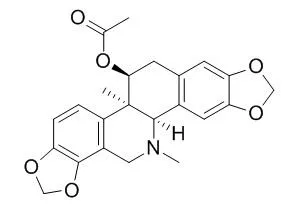| In vivo: |
| Neuropharmacology. 2014 Jul;82:108-20. | | Acetylcorynoline attenuates dopaminergic neuron degeneration and α-synuclein aggregation in animal models of Parkinson's disease.[Pubmed: 23973292] | Parkinson's disease (PD), the second most common neurodegenerative disease, impairs motor skills and cognitive function. To date, the drugs used for PD treatment provide only symptomatic relief. The identification of new drugs that show benefit in slowing the decline seen in PD patients is the focus of much current research. Acetylcorynoline is the major alkaloid component derived from Corydalis bungeana, a traditional Chinese medical herb. It has been shown to have anti-inflammatory properties, but no studies have yet described the effects of Acetylcorynoline on PD. The aim of this study was to evaluate the potential for Acetylcorynoline to improve PD in Caenorhabditis elegans models.
METHODS AND RESULTS:
In the present study, we used a pharmacological strain (BZ555) that expresses green fluorescent protein specifically in dopaminergic neurons, and a transgenic strain (OW13) that expresses human α-synuclein in muscle cells to study the antiparkinsonian effects of Acetylcorynoline. Our experimental data showed that treatment with up to 10 mM Acetylcorynoline does not cause toxicity in animals. Acetylcorynoline significantly decreases dopaminergic neuron degeneration induced by 6-hydroxydopamine in BZ555 strain; prevents α-synuclein aggregation; recovers lipid content in OW13 strain; restores food-sensing behavior, and dopamine levels; and prolongs life-span in 6-hydroxydopamine-treated N2 strain, thus showing its potential as a possible antiparkinsonian drug.
CONCLUSIONS:
Acetylcorynoline may exert its effects by decreasing egl-1 expression to suppress apoptosis pathways and by increasing rpn5 expression to enhance the activity of proteasomes. | | Yao Xue Xue Bao. 1997 May;32(5):331-6. | | [Protective action of corynoline, acetylcorynoline and protopine against experimental liver injury in mice].[Pubmed: 11498866] |
METHODS AND RESULTS:
Oral administration of two doses of corynoline, Acetylcorynoline or protopine at 50 and 100 mg.kg-1 in an interval of 8 to 24 h before i.p. injection of CCl4, acetaminophen or thioacetamide significantly impeded the elevation of serum transaminase (SGPT) and liver damage in mice. The three compounds were found to inhibit CCl4-induced microsomal lipid peroxidation and CCl4 conversing to carbon monoxide in liver microsomes in vitro.
CONCLUSIONS:
Of these compounds, Acetylcorynoline was shown to be more potent than corynoline and protopine. In addition, all the three compounds exhibited biphasic effects on the hepatic cytochrome P450, i.e. inhibition followed by induction, in mice. |
|






 Cell. 2018 Jan 11;172(1-2):249-261.e12. doi: 10.1016/j.cell.2017.12.019.IF=36.216(2019)
Cell. 2018 Jan 11;172(1-2):249-261.e12. doi: 10.1016/j.cell.2017.12.019.IF=36.216(2019) Cell Metab. 2020 Mar 3;31(3):534-548.e5. doi: 10.1016/j.cmet.2020.01.002.IF=22.415(2019)
Cell Metab. 2020 Mar 3;31(3):534-548.e5. doi: 10.1016/j.cmet.2020.01.002.IF=22.415(2019) Mol Cell. 2017 Nov 16;68(4):673-685.e6. doi: 10.1016/j.molcel.2017.10.022.IF=14.548(2019)
Mol Cell. 2017 Nov 16;68(4):673-685.e6. doi: 10.1016/j.molcel.2017.10.022.IF=14.548(2019)